
4 minute read
幕牆熱工分析和 防熱設計
from The FACADE #27
by ROF Media
邊界條件和典型幕牆節點的選取
本文以中國廣東省深圳市(北緯22°)作為 亞熱帶氣候的代表,深圳的夏季室外溫度 和太陽輻射照度見表1[3],室外風速2.2 m/s,室外對流換熱係數12.8 W/(m2·K) ,室內對流換熱係數2.5 W/(m2·K),室內 溫度25℃,室內相對濕度50%。
熱工分析對象選為幕牆層間的下端橫 梁,按照以下配置進行排列組合,總共 6種節點(圖1)。 框有三種:明框非斷 熱、明框斷熱(24mm尼龍隔熱條)、隱 框;可視玻璃有一種:夾層中空Low-e玻 璃(6+1.52PVB+6Low-e+12A+6),鋁 間隔條;層間玻璃有兩種:夾層單片玻璃 (6+1.52PVB+6)、夾層中空Low-e玻璃( 與可視玻璃相同);
熱工分析結果
使用 THERM 進行熱工建模計算,各節點 的溫度分佈情況如圖2所示。
玻璃中心區域的溫度 這裡分別統計了內片玻璃表面(圖4)和外 片玻璃內部(圖5)的溫度(取值點如圖3所 示)。所示)。
2) For the laminated glass, including both laminated monolithic glass and laminated Low-e IGU, the maximum temperature of PVB interlayer is 72.6ºC, and the time duration of the temperature exceeding 60ºC is about 3.5~4 hours. According to a number of researches by the industry experts, long-term high temperatures will adversely affect the performance of PVB laminated glass, including: a) As the temperature increases, the stiffness of the PVB laminated glass gradually decreases, and the bending performance will be weakened [4]. b) As the temperature increases, the shear strength of the broken PVB laminated glass decreases rapidly [5]. c) Long time being in a 60ºC-85ºC environment creates bubbles in the PVB interlayer and reduces the service life of laminated glass.
Frame and glass edge temperature
Figure 6 shows the temperature indicator of frame and glass edge.
According to ISO 7730, a comfortable indoor temperature in summer is 24ºC-28ºC[6]. “Assessment standard for healthy building, T/ASC02-2016” requires that the maximum temperature of the inner surface of the external wall is not higher than the indoor air temperature of +3ºC[7]. However, regarding the temperature of curtain wall, currently, there is no specific code or regulation. Considering that the maximum temperature of inner pane glass is 37ºC, in this paper, 40ºC is set as the critical temperature for the inner surface of curtain wall.
Figure 7 shows the temperature of the frame. Figure 8 shows the temperature of glass edge.
From the above figures, the thermal insulation performance of the curtain wall are ranked from the best to the worse as following:

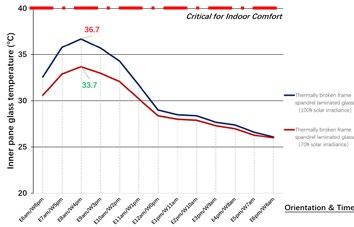
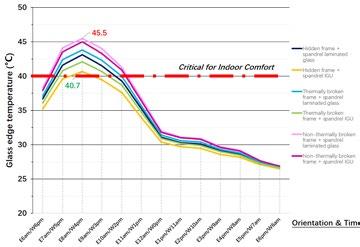
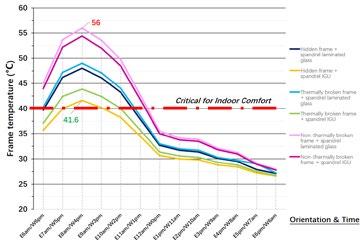
Hidden frame + spandrel IGU >
Thermally broken frame + spandrel IGU >
Hidden frame + spandrel laminated glass >
Thermally broken frame + spandrel laminated glass >
Non-thermally broken frame + spandrel IGU >
Non-thermally broken frame + spandrel laminated glass.
The maximum and minimum temperatures of the frame and glass edges differ by 13ºC and 5ºC respectively, where:
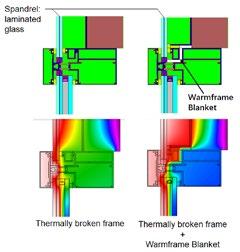
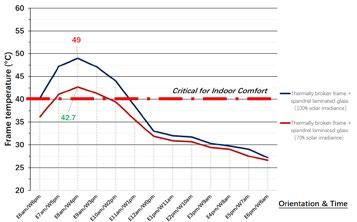
1) Regarding the non-thermally broken frame system, the maximum temperature of the frame and glass edge is 56ºC and 46ºC respectively, and the time duration of frame temperature exceeding 40ºC is about 5.5 hours.
2) Regarding the non-thermally broken frame system, the maximum temperature of frame and glass edge for the spandrel IGU is 5.1ºCand 1.7ºC lower than those of the spandrel laminated glass. The time duration of frame temperature exceeding 40ºC is also reduced from 4.5 hours to 3.5 hours.
3) Regarding the hidden frame system, the maximum temperature of frame and glass edge for the spandrel IGU is 6.4ºCand 2.4ºC lower than those of the spandrel laminated glass. The time duration of frame temperature exceeding 40ºC is also reduced from 4.5 hours to 2 hours.
Overheating protection design Option 1: External sunshades
Having external sunshades helps to avoid direct sunlight on the exterior surface of the curtain wall, thereby reducing the solar heat gain. Taking the thermally broken frame with spandrel laminated glass as an example, assuming that the solar irradiance is reduced by 30%, the temperature of each component are as following (Figures 9, 10, 11, 12).
As can be seen from the above figures, under the 70% of the solar radiation, the temperature of all components have been reduced significantly, especially the temperature of the outer pane glass lowers by 12ºC.
It means that external sunshades not only improve the indoor thermal comfort, but also reduce the risk of the PVB interlayer overheating.
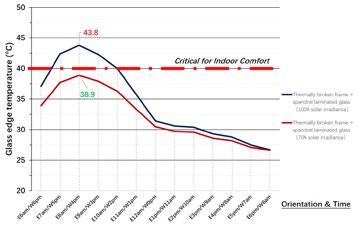
Option 2: High-performance Warmframe
As mentioned earlier in this paper, the frame and spandrel glass types have little impact on the temperature of glass center, but have a great impact on the temperature of frame glass edge. Based on the traditional thermal break system, the effect of using high-performance Warmframe (Figure 13) is: the temperature of frame lowers by 9.4ºC (Figure 14), and the temperature of glass edge lowers by 3.9ºC(Figure 15), which contributes to avoid the overheating problem and maintain the comfortable indoor environment.
Conclusion
In this paper, THERM software is used to simulate and sort out the component temperatures of typical curtain wall systems in the subtropical region in summer, and the following conclusions are obtained:

1) The temperature of glass center varies upon the outdoor temperature and solar irradiance. The types of frame and spandrel have little impact.
2) When laminated glass is used as the outer pane of glass, the impact of long-term high temperature environment should not be ignored. For the curtain wall facing east and west, interlayers with better thermal stability may be considered for safety concerns.
3) The thermal insulation structures of frame and spandrel glass types have a major impact on the indoor temperature of the frame and glass edge.
4) Having external sunshades is effective to avoid the overheating of curtain wall. For the curtain wall without external sunshade, high-performance Warmframe may be considered to lower the temperature of frame and glass edge in summer.
5) When designing curtain wall projects in subtropical regions, especially when there are specific requirements for indoor thermal comfort, to avoid overheating, it is recommended to carry out the thermal analysis using two-dimensional thermal finite element analysis software.
REFERENCES
[1] Chen Hongbing, Tu Guangbei, Li Deying. Impact of curtain wall for building energy consumption. [C]// China heating ventilation and air conditioning annual conference. 2004 陳紅兵, 涂光備, 李德英. 玻璃幕牆對建築能耗的影響[C]// 全國暖通空調 製冷2004年學術年會資料摘要集(2). 2004
[2] Chen Fangzhi. New viewpoint of fenestration in tropical climate [C]. FDC Seminar. Beijing. 2015 陳方志. 熱帶氣候節能門窗的新視角[C]. 2015年FDC研討會門窗幕牆的 節能與創新,北京,2015 [3] MOHURD of China. Design code for heating ventilation and air conditioning of civil buildings. GB50736-2012[S]
中華人民共和國住房和城鄉建設部. 民用建築供暖通風與空氣調節設計 規範 GB50736-2012[S]
[4] Huang Xiaokun, Liu Gang, Stephen J Bennison. Experimental Research on Bending Behavior of Laminated Glass Panels under Various Temperature[C]. China fenestration annual conference. Beijing. 2010 黃小坤,劉剛,史蒂文·本尼森. 不同溫度下夾層玻璃受彎性能試驗研究 [C]. 2010年全國鋁門窗幕牆行業年會論文. 北京.2010
[5] Mohammad Amin Samieian, David Cormie, David Smith, Will Wholey, Bamber R. K. Blackman, John P. Dear, Paul A. Hooper. Temperature Effects on Laminated Glass at High Rate, International Journal of Impact Engineering, Volume 111, January 2018, Pages 177-186

[
6] Ergonomics of the thermal environment – Analytical determination and interpretation of thermal comfort using calculation of the PMV and PPD indices and local thermal comfort criteria. ISO7730-2005[S]
[7] The architectural society of China. Assessment standard for healthy building. T/ASC02-2016[S]
中國建築學會. 健康建築評價標準T/ASC02-2016[S]
Build4Asia 2023 is the No.1 Trade show for the Building, Electrical Engineering and Security Industries in Hong Kong which covers every facet of the construction industry from building materials and automation, smart city technologies, property management to total surveillance system.
Build4Asia 2023是香港領先的建築、電氣工程和防火保安展覽會,帶來 一系列建造業嶄新產品、科技及服務,包括建築材料、樓宇自動化系統、 智能家居、安全檢測系統、物業管理等。
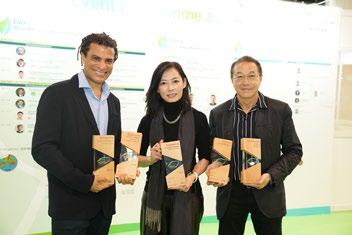
8,000+
Feedback from Exhibitors

參展商感言:
Build4Asia is the biggest exhibition (building industry) in Hong Kong. It is the biggest opportunity for our type of company. The customers can come here to touch and feel, and they can also see the live demo. I think that is what the most important.
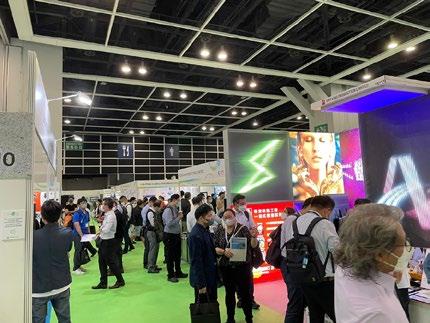
Eligible Hong Kong exhibitors may apply for the "SME Export Marketing Fund" to save up to 50% exhibiting costs!
合資格的參展商可申請「中小企業市場推廣基金」,節省高 達50%的參展費用!






